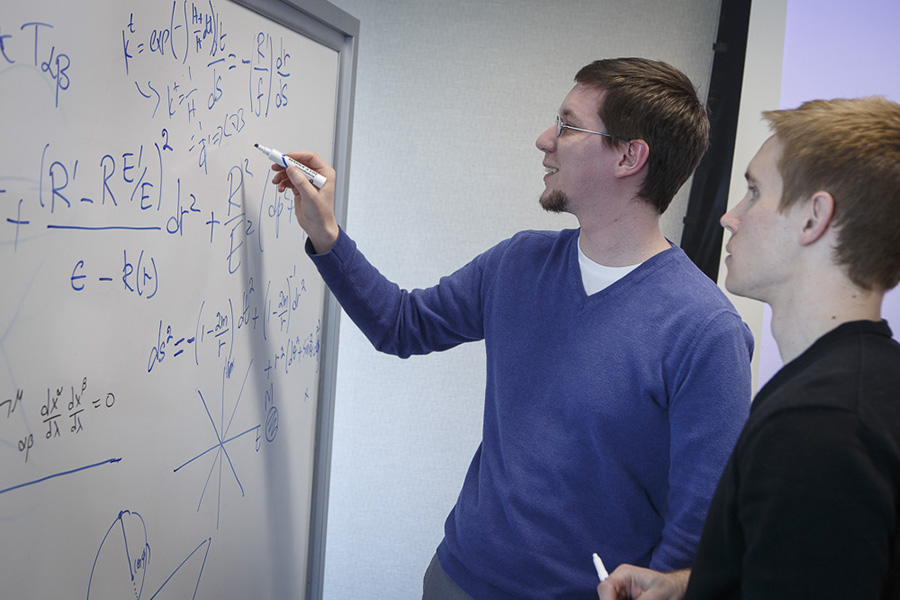
UT Dallas undergraduate physics student Jacob White talked with members of the public who had questions about astronomy and astrophysics at the recent lecture "Mysteries of the Dark Universe," part of the 27th Texas Symposium on Relativistic Astrophysics.
It’s commonplace to find graduate and undergraduate students at The University of Texas at Dallas taking part in hands-on research projects throughout campus.
But several UT Dallas students recently gained experience in additional aspects of academic research when they participated in the 27th Texas Symposium on Relativistic Astrophysics, an international scientific conference the University hosted last month.
Faculty and staff in the Department of Physics and the Office of Research spent nearly two years planning to host the symposium, which was held in downtown Dallas and on the UT Dallas campus Dec. 8-13. The conference marked the 50th anniversary of the prestigious astrophysics meeting; the first Texas Symposium was held in 1963 in Dallas and was hosted by UT Dallas’ precursor institution, the Graduate Research Center of the Southwest.
The 2013 conference, which drew more than 400 participants, provided UT Dallas students with opportunities to interact with the world’s top experts in astrophysics.
Undergraduate physics student Jacob White pulled double-duty during the conference. He participated in an outreach event on the UT Dallas campus, where he answered questions about astrophysics from members of the public and also gave a scientific talk to an audience of distinguished international researchers.
White’s work with Dr. Lindsay King, associate professor of physics, focuses on examining data from a 200 million-year-old collision between two clusters of galaxies, an event designated as Abell 2146.

Doctoral student Michael Troxel and Austin Peel also presented their research at the symposium.
Student Researchers Instrumental in Planning International Symposium
Michael Troxel, a doctoral student in the physics department, was part of the local organizing committee for the symposium. He was instrumental in much of the behind-the-scenes logistics of the event, including the design and maintenance of the symposium’s website, coordinating emails and other communications to conference participants, and helping to organize the program.
“Michael’s work for the symposium was very significant in quality and quantity. We are all very proud of him,” said Dr. Mustapha Ishak-Boushaki, associate professor of physics, co-chair of the symposium and Troxel’s dissertation advisor. Ishak-Boushaki noted that in addition to organizing the symposium, he and Troxel have worked together on three scientific publications in the past year.
Troxel and fellow physics doctoral student Austin Peel presented their research at the symposium. Peel discussed work that has implications for understanding the large-scale structure and dynamics of the universe. Troxel presented his work on gravitational lensing, which can be used to more accurately measure the distribution and density of matter in the cosmos.
“The age of the universe is thought to be about 13.7 billion years, so on cosmological time scales, this collision didn’t happen that long ago,” King said.
White’s project involved reducing and analyzing data from Abell 2146 that was gathered by a colleague, Dr. Rebecca Canning at Stanford University, who used a telescope at the Gemini Observatory in Hawaii. Light from the 200 or so colliding galaxies enters the telescope through a grating, which splits the light into its spectrum of colors, much like a prism splits sunlight into a rainbow. Such spectroscopic data reveals more information than can be gathered with photos alone, White said.
“Different elements and processes have characteristic spectra,” he said. “For example, we can determine the chemistry of what each galaxy is made of, as well as how it’s moving. We also can get an estimate of the mass of each cluster as a whole.”
The next step in his work, White said, is to look more closely at the spectroscopic data to learn about the chemical composition of the region.
“The chemistry can tell us which regions might be forming new stars,” he said. “Sometimes a collision itself can spur an area of unusually active star formation.”
King said Abell 2146 is one of fewer than 10 suspected galaxy cluster mergers in the universe that are at just the right angle as seen from Earth for scientists to get a good view.
One of the mysteries of Abell 2146 is that the amount of matter that can be seen by telescopes does not provide enough gravitational, or attractive, force to account for how the galaxies are moving.
“There has to be about 10 times as much stuff that we can’t see,” King said. “The galaxies are not moving as they would if the movement was just due to what’s visible. This provides us with evidence that there is dark matter here.”
Although it can’t be seen directly, dark matter is thought to comprise about 27 percent of the universe; without it, galaxies might fly apart. The UT Dallas team, which also includes graduate student Joseph Coleman, is using gravitational lensing techniques and data from the Hubble Space Telescope to map the dark matter in the system.
“One of the things we’re trying to figure out is, at what point in the merger these two clusters are,” King said. “We think they’ve passed through one another, but it’s not clear whether they are now being drawn back together again due to gravitational attraction.”
The team’s research is funded in part by NASA and the Texas Space Grant Consortium. White also has received support from UT Dallas’ Undergraduate Research Scholar Award Program.